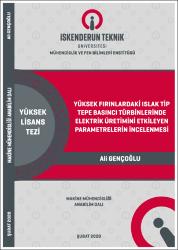| dc.contributor.advisor | Karakuş, Cuma | |
| dc.contributor.author | Gençoğlu, Ali | |
| dc.date.accessioned | 2020-12-01T08:09:05Z | |
| dc.date.available | 2020-12-01T08:09:05Z | |
| dc.date.issued | 2020 | en_US |
| dc.date.submitted | 2020 | |
| dc.identifier.citation | Gençoğlu, A. (2020). Yüksek fırınlardaki ıslak tip tepe basıncı türbinlerinde elektrik üretimini etkileyen parametrelerin incelenmesi. (Yüksek Lisans Tezi). İskenderun Teknik Üniversitesi / Mühendislik ve Fen Bilimleri Enstitüsü, Hatay. | en_US |
| dc.identifier.uri | https://hdl.handle.net/20.500.12508/1418 | |
| dc.description.abstract | Enerji ihtiyacının gün geçtikçe artış gösterdiği günümüzde, yeni enerji kaynakları arayışı giderek daha fazla önem kazanmıştır. Buna göre, enerji ihtiyacını azaltma, enerjiyi daha verimli kullanma veya atık enerjiyi geri kazanma metotları üretilmesi konusunda çalışmalar yapılmaktadır. Yapılan bu çalışmalardan bir tanesi de EDÇF (Entegre Demir-Çelik Fabrikaları)'de uygulanan yüksek fırın gazı tepe basıncı geri kazanım türbin uygulamasıdır. Tepe basıncı türbini (TBT), yüksek fırın üretim sürecinin bir çıktısı olan, yüksek basınç ve sıcaklıktaki yüksek fırın gazının sahip olduğu enerjiyi elektrik enerjisine dönüştüren bir türbin-jeneratör sistemidir. Yapılan bu çalışma ile TBT'lerin çalışma mantığı anlatılmış; örnek bir TBT'nin süreç parametreleri incelenmiştir. Ortalama gözlem değerlerine göre yapılan hesaplamaya göre örnek TBT ile %26 civarında bir enerji geri kazanımı yapılabileceği görülmüştür. TBT sistemi üretimini etkileyen değişkenlerin sırayla TBT üretimiyle olan ilişkisi (korelasyon) araştırılmıştır. TBT giriş gaz debisinin ve giriş gaz basıncının TBT üretimi ile orta güçte pozitif bir ilişkiye sahip olduğu anlaşılmıştır. Gaz debisinin 100.000 m3/saat artışı 2,6 MW, giriş gaz basıncının 100 kPa artışı 3,6 MW daha fazla güç üretimi sağlamaktadır. Söz konusu TBT sistemine ait üretim değerleri ampirik olarak da hesaplanırken bir Çoklu Lineer Regresyon (ÇLR) modeli yine bu çalışmada kullanılan parametrelere dayalı bir model önerisi olarak sunulmuştur. Nihayetinde ise sistem gözlem değerleri, ampirik formüllere dayalı teorik üretim değerleri ve ÇLRM modelinin tahmin ettiği değerler, hata değerlendirme kriterleri ortalama karesel hata (Mean Squared Error-MSE), ortalama mutlak yüzdesel hata (Mean Absolute Percentage Error-MAPE) ve varyans (R2) değerleri ekseninde kıyaslanmıştır. Buna göre ÇLR modelin 0,9205 R2 değeri ile daha güçlü tahmin yeteneğine sahip olduğu görülmüştür. TBT ile enerji geri kazanımı yapılması sayesinde karbon emisyonunun 53020 ton/yıl azaltılabileceği hesaplanmıştır. | en_US |
| dc.description.abstract | In these times when the need for energy is increasing, the search for new energy sources has become more and more important. Accordingly, studies are carried out to reduce the need for energy, to use energy more efficiently or to produce waste energy recovery methods. One of these studies is the application of blast furnace top pressure recovery turbine applied in IISF (Integrated Iron and Steel Factories). Top pressure recovery turbine (TRT) is a turbine-generator system that is an output of the blast furnace production process, converting the energy of blast furnace gas at high pressure and temperature into electrical energy. With this study, the working principle of TRT's was explained and the process parameters of a sample TRT were examined. According to the calculation made according to the average observation values, it was seen that an energy recovery of around 26% could be achieved with the sample TRT. The relationship (correlation) of variables affecting TRT system production with TRT production was investigated. It was understood that the inlet gas flow and inlet gas pressure of TRT had a positive correlation with the medium power of TRT production. An increase of 100.000 m3/h of gas flow is 2,6 MW, and an increase of inlet gas pressure of 100 kPa is 3,6 MW for more power generation. While the production values of the TRT system are calculated empirically, a Multiple Linear Regression (MLR) model is presented as a model proposal based on the parameters used in this study. System observation values, theoretical production values based on empirical formulas and predicted values of MLR model were compared on the axis error evaluation criteria mean squared error (MSE), mean absolute percentage error (Mean Absolute Percentage Error-MAPE) and variance (R2) values. Accordingly, it was observed that the model of the MLR has a stronger predictive ability with a R2 value of 0,9205. It is calculated that carbon emission can be reduced by 53.020 tons/year by energy recovery with TRT. | en_US |
| dc.language.iso | tur | en_US |
| dc.publisher | İskenderun Teknik Üniversitesi / Mühendislik ve Fen Bilimleri Enstitüsü / Makine Mühendisliği Anabilim Dalı | en_US |
| dc.rights | info:eu-repo/semantics/openAccess | en_US |
| dc.subject | Tepe basıncı türbini | en_US |
| dc.subject | Entegre demir-çelik fabrikası | en_US |
| dc.subject | Enerji geri kazanımı | en_US |
| dc.subject | Çoklu lineer regresyon | en_US |
| dc.subject | Karbon emisyonu | en_US |
| dc.subject | Top pressure recovery turbine | en_US |
| dc.subject | Integrated iron and steel factory | en_US |
| dc.subject | Energy recovery | en_US |
| dc.subject | Multiple linear regression | en_US |
| dc.subject | Carbon emission | en_US |
| dc.title | Yüksek fırınlardaki ıslak tip tepe basıncı türbinlerinde elektrik üretimini etkileyen parametrelerin incelenmesi | en_US |
| dc.title.alternative | Investigation of parameters affecting electricity generation in wet type top pressure recovery turbine systems in blast furnace | en_US |
| dc.type | masterThesis | en_US |
| dc.contributor.department | Mühendislik ve Fen Bilimleri Enstitüsü | en_US |
| dc.relation.publicationcategory | Tez | en_US |
| dc.contributor.isteauthor | Karakuş, Cuma | |
| dc.relation.index | İndeks Bilgisi Yok | en_US |
















